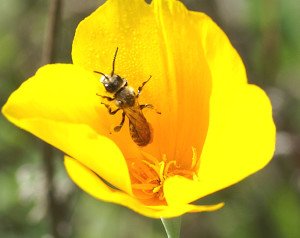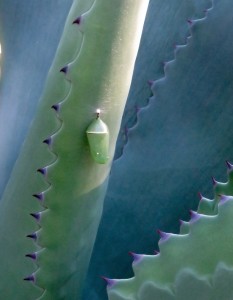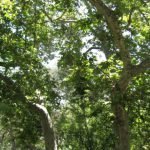Who doesn’t want more butterflies in their yards? You need nectar plants of course. But if you want to watch all the butterfly stages — which means your plant’s leaves will get eaten by the growing caterpillars — you need to include specific host plants, such as milkweed for monarchs, or thistle or mallow for Painted Ladies.
But you also need to watch your use of pesticides. Oh, and keep some weeds around.
These were among the important takeaways of the forum “Where have all the Butterflies and Bees Gone? How to Protect our Butterflies and Pollinators,” sponsored by the Inland Empire Resource Conservation District (IERCD) and the Redlands Sustainability Network on Saturday, November 14th in Redlands, CA.
Butterfly expert Moe Magoski and pollinator specialist Michael Klein, who together have 90 years of experience with some of our smallest critters, offered tips on how attract butterflies, bees and other important pollinators to your yards.
Pollinators – more than just honeybees
Klein, who began as a butterfly hobbyist as a kid, and moved on to pollinators in his career as a wildlife biologist, surprised people with info on the many pollinators in our midst. Aside from the important European honeybee, which pollinates so many crops, Klein pointed out that hundreds of other bees, plus numerous flies, beetles and moths are important pollinators.
Did you know:

- 100% of our native bees pollinate
- over 70% of our flies
- one-third of our beetles pollinate, and…
- one out of 10 moths
“If we remove pollinators and other insects from our area, from the world, humans die. Insects are critical daily for human survival and it’s important to find ways to encourage them into our yards,” he said. He cited Albert Einstein, who said, “If the bee disappeared off the surface of the globe, then man would have only four years of life left. No more bees, no more pollination, no more plants, no more animals, no more man.” Click here for more photos and stats about native pollinators.
Attracting pollinators and butterflies
- First, was don’t use pesticides, which kills the good insects along with the bad ones.
- Adjust the plants in your yard to meet what you want to attract. For example, native plants will attract many varieties of native pollinators as well as the important European honeybee. (Research has shown that the presence of native pollinators makes the honeybees work even harder.)
- To attract adult butterflies as they fly through your yard in search of nectar plants (and the specific host plants that they require to lay their eggs), here in the West you should consider native plants like buckwheats, ceanothus (wild lilac) and sages (salvias) which provide important nectar. Non-natives such as lavender, rosemary, and lantana also provide nectar during many parts of the year. You can find more plants on this Xerces.org website – scroll down halfway to find your region.
- To watch all the butterfly stages, you need host plants, which means the caterpillar will eat them down as they pass through five stages called instars.
Common butterfly and their host plants

Magoski shared info about the following Southern California’s butterflies and their host plants. (Did you know: Southern California has over 212 species of butterflies)
The Popular Monarch: Along with the Queen butterfly (pictured in this post’s featured photo), monarchs require milkweed, of which there are many types. “The tropical milkweed (Asclepsias curassavic) is not local or native but is great to have because it blooms the longest and into the winter months. It’s also good to have the other local native varieties, which bloom at different times of the year,” says Magoski. They also require slightly less water.
Local native varieties of milkweed from Butterfly Farms in Encinitas at the forum’s plant sale included three local varieties:
- Desert Milkweed (Asclepius erosa) which as its name suggests, grows in the desert but does well in the Inland area’s minimal rainfall. It blooms in May through July and features white to yellow flowers.
- Pine Needle milkweed (Asclepius linaria), has leaves that look like their name, grow several feet high and bloom white flowers most of the year (April through November).
- Narrowleaf milkweed (Asclepius fascicularis) is a common milkweed that grows two to three feet, with snowy white to pink clusters that bloom May through September. I’ve now planted them all, choosing sunnier, drier areas for the native ones.
We’ve planted all of these. Click here for our experience with monarchs this fall (including a caterpillar that walked 50 feet looking for the perfect spot to make its chrysalis).
Free Milkweed Seeds!
Also, Ann and John Ward launched SaveOurMonarchs Foundation dedicated to saving the Monarch Butterfly by distributing milkweed seeds for their survival. Anyone can get Free Milkweed Seed Packets at the link above, and according to John, for the holiday season you can get 50 Seed Packets for each $19 donation.
Fennel, citrus and elms for Swallowtails
Other butterflies you might attract are the Anise Swallowtail, which hosts on fennel, but also anything in the carrot or parsley family. “So if people have herb gardens and grow dill, parsley, celery, etc. the Anise caterpillars will feed on the leafy material,” said Klein. In the field, Klein has also witnessed Anise caterpillars using the native Touschia, especially Touschia argute, also called Southern umbrellawort. Other swallowtail and their host plants are the Western Tiger Swallowtail (Sycamore and Willow) and the Giant Swallowtail (Citrus and Rue).

Other popular butterflies include Gulf Fritillary, which requires Passion Vine. We planted one in San Diego and amazingly, had caterpillars on it within months. Others and their host plants are the Cloudless Sulfur (assorted Cassias), Painted Lady (Thistles and Mallow) and the Buckeye (Plantain, Snapdragon and Penstemon) and the Mourning Cloak (assorted Elms, Willows and Cottonwood).
Keeping some weeds around
Magoski shared how he collected hundreds of buckeye caterpillars from an empty lot that were feeding on plantain, what many would call weeds. Buckeyes need plantain or snapdragons and penstemons as their host plants. He left hundreds of caterpillars but when he returned a couple weeks later, the lot had been weedwhacked down to stubble.
Magoski encourages people to check for caterpillars and leave some for them to feed on. “In addition to plantain, common plants that people consider weeds, but are important for butterflies, are mallow or cheeseweed, fennel, and asters such as cudweed and pearly everlasting.” Click here for more on weeds and for resources.
Here’s a follow-up post with more info on their talk.
Both Klein and Magoski said they’re available to identify butterflies or pollinators. Call or text caterpillar or butterfly photos or questions to Moe Magoski at 760-580-7989, or email Michael Klein at Michael@klein-edwards.com with pollinator questions.
Sounds like a wonderful day full of education. Sorry I had to work. I’ve met Moe and know how passionate he is about butterflies. Thanks for sharing Linda Richards. God Bless O:)
Sorry you missed it Monika (who runs a monarch way station and is a great speaker on butterflies…) and for helping us all understand and appreciate butterflies